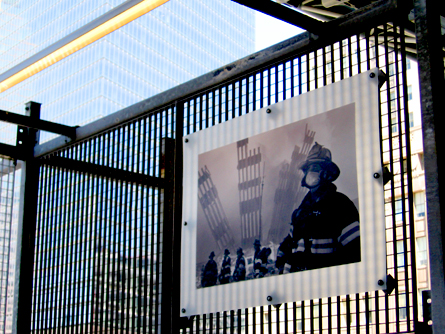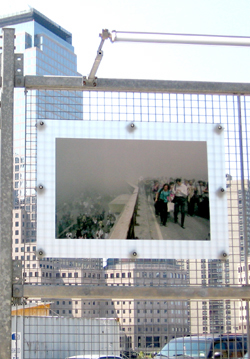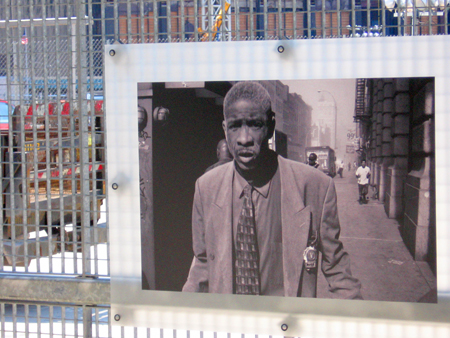
Covered completely in ash from the collapse of the twin towers, the clothes in Chelsea Jeans in lower Manhattan remained in the store window for 13 months after 9/11, presented and preserved by David Cohen, the store's owner. In October 2002, his display was packed into hermetically sealed crates. Now the crates have been unsealed and the scene recreated, literally, as a museum piece. They are now on display in a glass case next to the cafeteria in the basement of the New York Historical Society.
New Yorkers are preparing to mark the fifth anniversary of September 11. There are exhibitions at the Brooklyn Museum and the Police Museum, retrospective panel discussions, a new movie and a new book that promised to stir up controversy, and a day of commemoration planned for Ground Zero itself, ending with the Tribute in Light, an art installation intended to be a one-time deal that has morphed into a periodic memorial
The permanent memorial, meanwhile, is still a series of architectural drawings.
Like previous anniversaries, the fifth anniversary will undoubtedly inspire not only reflection on the attacks but also on the progress that has been made in rebuilding the city. This September 11, though, there is little to mark except the passing of time. Ground Zero looks more or less what it looked like on its fourth birthday or, for that matter, its third. The general public is no longer following the debate what the memorial should look like, or what kind of retail stores should go there. The agency in charge of coordinating the rebuilding of the site – the Lower Manhattan Development Corporation – says it is "nearing the end of [its] mission", and had declared itself defunct.
Many of those involved say that the progress continues, even if it isn’t visible to the naked eye. The transportation hub, which has always been immune to the vitriol and stagnation of the memorial and the Freedom Tower, remains on schedule. Designs for the remaining three towers will be unveiled this week, the first time that plans for the entire site will be made public. The change in administration in Albany, many believe, will push forward turning this plan into actual buildings.
Each reassurance, though, seems to carry less weight with New Yorkers who marked the “symbolic beginning” of the construction at Ground Zero – the laying of the cornerstone of the Freedom Tower – over two years ago. This summer, the cornerstone was actually removed from Ground Zero, as newfound concerns about where on the site the Freedom Tower should be built arose. It has not returned.
When construction will be completed, or what, exactly, will be built are still open questions. Meanwhile the pain from the attacks themselves has been dulled by another passing year. Have we gotten over it?
"I think people are sick of hearing about closure," said Amy Weinstein, the curator of Elegy in the Dust, the exhibit at the New York Historical Society. "But I think that with the passage of time, things have changed. People have some perspective, a little distance, or a measured appreciation for how their lives have changed."
Investigative reporter Wayne Barrett believes that time has healed the pain enough to raise questions that would have been taboo in years past. His new book Grand Illusion questions former Mayor Rudolph Giuliani's legacy as a 9/11 hero; in a recent interview he said he has long had the material to write the book, but held off until he and his publishers thought people would be ready.
"There had to be an adjustment period," he said.
For those most affected by the attacks – those who lost loved ones, those who are getting sick from exposure to the chemicals released in the buildings’ collapse, and those who live and work in the immediate area – life didn’t return to what it was before 9/11. Cohen of Chelsea Jeans, for example, watched as his store went out of business as downtown's economy dried up after 9/11. He moved his family out of the city he had immigrated to almost twenty years earlier, and started over in Florida.
FIVE YEARS LATER
 Life in the city is different than it was before 9/11. In some ways, the changes are subtle, or have been internalized. In others, it remains unclear how the aftermath of 9/11 will play out years from now.
Life in the city is different than it was before 9/11. In some ways, the changes are subtle, or have been internalized. In others, it remains unclear how the aftermath of 9/11 will play out years from now.
Security: The single factor that has changed the everyday life of New Yorkers more than anything else since 9/11 is the increase in security.
The most visible tightening is at the airports and in the air. But there is a greater police presence on the ground, and underground. Bags on the subways are searched randomly. Earlier this year the police department announced that it would establish a "ring of steel" around lower Manhattan, recording every person or vehicle to go south of Chambers Street. The project has been put on hold because of a reduction in anti-terrorism funding – an issue that has suddenly become a constant source of tension between New York and the federal government – but aggressive surveillance measures continue to be put in place by the government and by private businesses.
The Partnership for New York City, a business group representing major employers, recently surveyed its members, finding that their costs for security have risen between 10 and 20 percent, well over the average increase nationwide. Insurance costs for companies operating in New York have also spiked.
There is a social price as well, says Donna Lieberman of the New York Civil Liberties Union, which is concerned about the city's willingness to subvert personal liberties for security. Often, the threat of terrorism is being used to monitor legal political activities in ways that would have been unacceptable before 9/11.
"When you don't feel the pain immediately, you don't notice the problem," she said. "It's very, very difficult to reverse practices like this."
Health: For years, officials have questioned whether there is a direct link between certain illnesses and exposure to chemicals released in the collapse of the Twin Towers. But just last week, the city sent guidelines to doctors for identifying illnesses related to 9/11. The state also recently passed a law giving more generous benefits to rescue workers whose illnesses seem 9/11-related.
The toll that 9/11 will eventually take on the health of those who worked on the rescue effort – or those who simply lived nearby – will likely continue for many years. But critics still say that there has been a failure to take responsibility for such sicknesses at all levels of government.
Economic Development: The aftermath of the attacks doomed individual businesses, like Chelsea Jeans or small manufacturers in Chinatown, who always operated on thin margins. But industries whose outcomes looked bleak several years ago are no longer struggling. Restaurants, tourism and retail, and the airline industry are operating at or above levels they were before 9/11. In fiscal 2006, the city's gross domestic product, a measure the comptroller's office uses to measure the city's overall economic output, surpassed its pre 9/11 peak for the first time since the attacks.
Some things, however, have changed.
Companies are also more apt for spread their operations geographically, instead of concentrating them in Manhattan. This, along with national economic trends, means that there are seven percent fewer finance jobs now than before the attacks, according to Kathryn Wylde, head of the Partnership for New York City.
Businesses want to ensure that they no longer rely solely on a single geographic location, she said, and have moved some operations out of New York as a result.
"That's probably a permanent dislocation."
REBUILDING LOWER MANHATTAN
The physical rebuilding of lower Manhattan – a project that gripped the attention of the city in a way unlike any before or since – has faded from the daily news. But what happens at Ground Zero remains vitally important for the city's economic – and emotional – recovery.
Lower Manhattan, says Wylde, has about 28,000 fewer jobs than it did before 9/11. This is roughly the number of people who worked at the World Trade Center, and "for obvious reasons, those jobs aren't back," she said.
Wylde and others see positive signs for the development of Ground Zero, but acknowledge that the project remains beset by frustration.
Positive Signs
Transportation Infrastructure: The one piece of the plan for Ground Zero that has moved smoothly is the transportation hub, designed by renowned architect Santiago Calatrava. A temporary PATH station already exists on the site, and is scheduled to be replaced by 2009.
One block away, the Metropolitan Transportation Authority is working on a new $750 million Fulton Street subway station. Critics have called the project unnecessary, but others say it will make the area a more attractive place to the businesses that will hopefully move into the offices at Ground Zero. It appears to be moving ahead on schedule.
"You have to realize the tremendous capital expenditure that's being made downtown to rebuild transportation, communication," said Brian Weld of Colliers ABR, a real estate firm. "The basic nuts and bolts of downtown are being entirely rebuilt."
A Better Business Climate? Even with improved transportation to the area, there have long been doubts that the commercial real estate market in New York could handle much new office space. There are signs today, however, that new office buildings would do well.
 Demand for new office space is strong. Vacancy rates are falling, and rents rising. Much of what is available downtown is in older buildings without large blocks of space. Many feel it seems ready for new buildings.
Demand for new office space is strong. Vacancy rates are falling, and rents rising. Much of what is available downtown is in older buildings without large blocks of space. Many feel it seems ready for new buildings.
7 World Trade Center: People looking to illustrate the strength of the market point to Seven World Trade Center, which World Trade Center site developer Larry Silverstein finished building in May. There were major concerns about the building's marketability, but it has filled about half of its 1.6 million square feet of office space. Weld takes this as a sign that the building is succeeding.
Open Questions
Despite the positive news literally surrounding Ground Zero, considerable concern remains about the signature pieces of the Ground Zero development.
Freedom Tower: The Freedom Tower, it seems, is immune to the sense of optimism about the prospects for commercial buildings downtown. It is commonly understood that Governor George Pataki sees it as his physical legacy to the 9/11 recovery, but many feel his political and personal commitment to the building has inspired him to push a project that may well fail.
The 1,776-foot tall Freedom Tower would contain about 2.6 million square feet of office space. It is further from public transportation than other buildings planned for Ground Zero, and is perceived as a possible terrorist target. There are no committed tenants for the building.
Governor Pataki says that government agencies will take at least one million square feet of space in the building, but critics do not see that as a guarantee. Two of the three gubernatorial candidates have expressed concern over the financial prospects of the tower. Eliot Spitzer has called it a "white elephant". While he says he is committed to building it if elected governor, he adds that he would reassess the project if the one million square feet were not leased when he took office.
The Other Towers: Some involved in rebuilding share Sptizer's concern. The Regional Plan Association has said the towers along the east side of the site -- bordering Church Street -- would be a better investment. It may make sense to build these buildings first, they say, gradually introducing new office space instead of glutting the market.
Designs for the three buildings are scheduled to be unveiled this week. At the moment, they are scheduled to be completed by 2012.
The Memorial: Civic groups who have been involved in the rebuilding would see the creation of a memorial as the primary immediate concern at the site.
"The lack of a memorial, the lack of a plaza, is a key problem," said David Kallick of the Fiscal Policy Association. "I don't think there's a problem with the buildings coming on line one by one as the market demand increases."
But the memorial has its own challenges. There is still controversy over how the victims' names will be displayed. That, combined with a general uncertainty over plans for the site, has made fundraising difficult. To date, the World Trade Center Memorial Foundation, which is in charge of building the memorial, has raised $132 million. Estimates for how much it will cost to complete the memorial range from $500 million to close to $1 billion.
Cultural Buildings: As Ground Zero is beset by funding concerns on all sides, it seems that the cultural buildings planned for the site have been orphaned.
"It's not on anybody's funding timetable," said Ric Bell of the American Institute of Architects. "Where does that leave culture on the site?"
The End of the Lower Manhattan Development Corporation: Despite these open questions, the agency formed to direct rebuilding announced this summer that it would soon go out of business.
The Lower Manhattan Development Corporation arranged the design competitions for the master plan for the site and the memorial, played a role in the controversies over the Freedom Tower, and passed out billions of dollars in public money for post 9/11 recovery.
"The LMDC had a mission and we're nearing the end of that mission," its chairman, Kevin Rampe, said at the time.
Most of the power over rebuilding has always rested with the governor, and many agreed that the organization had outlasted its usefulness. With a layer of bureaucracy gone, the decision-making would be sharpened.
"Not that they were a negative force, but the cacophony of voices I don't think was the most expeditious way to get decisions made," said Wylde of the Partnership for New York City.
The agency does have some issues it must resolve before it closes its doors, however. There are still tens of millions of dollars in grant money to be distributed. The agency says it does not have exact numbers on how much money it has, but newspaper reports indicate that there is about $45 million in "community enhancement" grants and another $7 million in cultural grants remaining. It is not clear who will distribute this money if the Lower Manhattan Development Corporation doesn't.
The agency has also not developed design guidelines to go with the master plan for the site. These would determine what the site would actually look like, from the actual buildings down to light fixtures and curbs. Failure to put such guidelines in place has been a sticking point for those who say they are a necessary part of the master plan.
"These questions will be resolved over the next couple of months, Michael Haberman, a spokesperson for the agency, said of the issues surrounding the grant money and the guidelines.
But Bell of the American Institute of Architects says that the agency's biggest failure has been its inability to get such guidelines in place. While an opportunity has been lost by not having them ready before design work began on the buildings, he says they are still "desperately needed."
JUST A HOLE IN THE GROUND?
Two weeks before the fifth anniversary of 9/11, New Orleans marked the first anniversary of Hurricane Katrina. In many ways it was like the first anniversary of 9/11: the intense media attention, the public grieving, the sharp questions about recovery.

In response to criticism that rebuilding in his city was not moving quickly enough, New Orleans Mayor Ray Nagin made the comparison explicit.
"You guys in New York can't get a hole in the ground fixed, and it's five years later. So let's be fair," he said on 60 Minutes. Nagin was making a point that is regularly made in the editorial pages of New York's newspapers, by public officials, and even by those who are involved in the rebuilding itself. As a statement of fact, it is indisputable. But any public statements about Ground Zero are likely to evoke an emotional response. Nagin was criticized harshly, and soon said he regretted the remarks – on a trip he made to New York City last week to entice investors into contribute to the rebuilding of New Orleans.
"I will never again refer to that site as a hole," said Nagin. "It's a sacred site that's currently in an undeveloped state."
Â